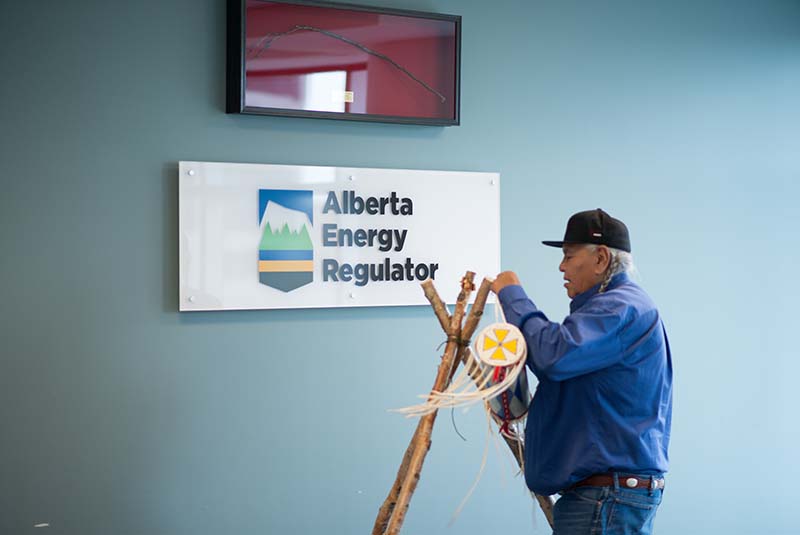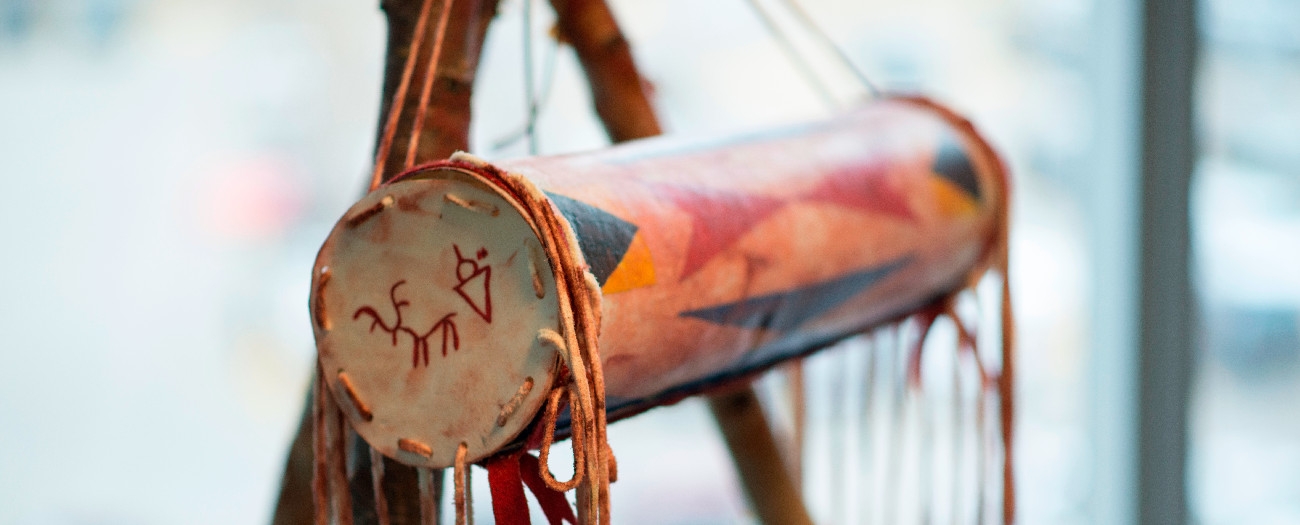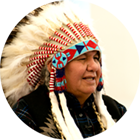The AER’s mandate can be understood through written word and through the lens of a traditional indigenous oral system.
Alberta - August 21, 2018We tend to think of a mandate as a string of words—a linear idea, maybe one that’s a little vowel-heavy. The Alberta Energy Regulator (AER) has something like that: our mandate is to ensure the efficient, orderly, and environmentally responsible development of energy resources in the province.
But if the AER were part of an oral society, like many indigenous cultures, it would take another form, too. Our mandate is also represented in a Blackfoot bundle: a rawhide-wrapped cylinder painted with symbols and perched on three birch poles.
A bundle is cultural material, collected. When you look at western documentation, you have chapters. When we look at the items in a bundle, each item is a chapter.
Dr. Reg Crow Shoe, Blackfoot Elder
Blackfoot Elder Dr. Reg Crow Shoe transferred a bundle to the AER in 2017 after guiding us on our journey to write Voices of Understanding: Looking Through the Window, a book that illustrates the parallels between indigenous and western decision-making and worldviews.
The bundle is an important recognition of the AER’s growing awareness and of our commitment to better develop relationships of mutual trust and understanding with indigenous peoples. The bundle teaches us about the importance of the oral system that is used traditionally by indigenous communities.
“The concept of a bundle came out of some of our discussions with the elders,” says Crow Shoe. “Elders were trying to interpret the concept of a western vision statement, and they started talking about how visions and missions were reflected in an oral system.”
In whatever form it takes, a mandate speaks to relationship, authority, and commitment. It’s important that the AER recognize both systems of decision making: the one described in the Responsible Energy Development Act, and the bundle that protects our mandate in the oral system.
What’s in a Bundle?
Inside the AER’s bundle is a copy of Voices of Understanding, an audio file of staff reading the book, and video from the information sessions held with the AER, Crow Shoe, and elders from the regions of Treaty 6 and Treaty 8.
“A bundle is cultural material, collected,” explains Crow Shoe. “When you look at western documentation, you have chapters. When we look at the items in a bundle, each item is a chapter.”
The materials inside of the AER’s bundle capture what we’ve learned from Crow Shoe and protect our mandate in an oral system. They will also serve as points of reference, not dissimilar to the way that an indigenous community might use a bundle, where items are removed from a bundle when needed, and their stories and songs are recalled to help communities make decisions.
Is it the Right Time?
The bundle may be new, but our efforts to make written and oral systems parallel are not.
“If I think about it,” says Crow Shoe, “we’re more than 15 years into it.”
Crow Shoe has worked with us before. In 2000, the regulator and Crow Shoe collaborated to write a facilitators’ guide to help indigenous youth understand how their traditional ways of learning and decision making relate to western processes.
In September 2017, Voices of Understanding was released publicly. Although the book’s purpose and audience are vastly different from the 2000 document, the intent is unchanged: we are on a shared journey to understand both systems and to work together.
On the day Voices of Understanding was launched, the project team and AER executives met with Crow Shoe and his wife, and fellow elder, Rose Crow Shoe. There, our bundle was forever changed. In a circle ceremony, the bundle was rubbed with red ochre—a naturally occurring paint sacred to the Blackfoot people. This protected the knowledge and processes behind the book.
But not only was the bundle protected that day. Crow Shoe and elders from Siksika Nation also painted members of the project team with ochre to protect them as they move forward to spread the knowledge contained in the bundle.
“Although our CEO Jim Ellis is the bundle holder, everyone who was involved in the project is still a helper and considered integral in helping the organization meet its objectives,” says Jason Veness, a senior advisor with AER’s Indigenous Engagement Group. For his work through the Voices of Understanding process, Veness was given a Blackfoot name—Pitaa Maakaa, which means “eagle traveller”—for his role helping the organization understand both indigenous oral and western systems.
“It is important that the AER staff are protected under the same process as the bundle. We strive to reciprocate the protection given to us to indigenous peoples in Alberta in our own way: through documents and processes,” Veness said.

What Does this Mean for the AER?
In indigenous communities, bundles are transferred to individuals who earn the right to hold that mandate by gaining knowledge and experience. In the AER’s case, the bundle should be passed on along the line of CEOs, meaning the successors to AER president and CEO Jim Ellis can also decide if they want to acquire the knowledge we gained on this journey.
Now that the AER has received this bundle, it is important to share our knowledge with others. We want to continue to develop a relationship with indigenous peoples in our province.
Crow Shoe explains his vision: “The bundle is paying respect to the written and oral systems, and putting together trust so the two systems can speak to each other. That’s how the AER is going to move ahead.”
Resource Editor
Luke Spencer, Digital Media



